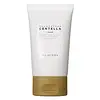What's inside
What's inside
 Key Ingredients
Key Ingredients

 Benefits
Benefits

 Concerns
Concerns

 Ingredients Side-by-side
Ingredients Side-by-side

Cetyl Ethylhexanoate
EmollientGlycerin
HumectantPentylene Glycol
Skin ConditioningHydrogenated Lecithin
EmulsifyingNiacinamide
SmoothingMacadamia Ternifolia Seed Oil
EmollientPEG-50 Shea Butter
EmulsifyingLimnanthes Alba Seed Oil
Skin ConditioningSqualane
EmollientCarbomer
Emulsion Stabilising1,2-Hexanediol
Skin ConditioningTromethamine
BufferingPanthenol
Skin ConditioningSodium Carbomer
Emulsion StabilisingErythritol
HumectantTrehalose
HumectantBetaine
HumectantButylene Glycol
HumectantCaprylhydroxamic Acid
Caprylic/Capric Triglyceride
MaskingAdenosine
Skin ConditioningLavandula Spica Flower Oil
MaskingXanthan Gum
EmulsifyingOzonized Olive Oil
Skin ConditioningHydroxyethylcellulose
Emulsion StabilisingOrange Roughy Oil
Skin ConditioningMadecassoside
AntioxidantBiosaccharide Gum-1
HumectantAsiaticoside
AntioxidantMalt Extract
Skin ProtectingAsiatic Acid
Skin ConditioningButter Extract
EmollientGlycyrrhiza Glabra Leaf Extract
Skin ConditioningCeramide AP
Skin ConditioningChamomilla Recutita Flower Extract
MaskingLinoleic Acid
CleansingEthylhexylglycerin
Skin ConditioningSodium Hyaluronate
HumectantLinolenic Acid
CleansingCetyl Ethylhexanoate, Glycerin, Pentylene Glycol, Hydrogenated Lecithin, Niacinamide, Macadamia Ternifolia Seed Oil, PEG-50 Shea Butter, Limnanthes Alba Seed Oil, Squalane, Carbomer, 1,2-Hexanediol, Tromethamine, Panthenol, Sodium Carbomer, Erythritol, Trehalose, Betaine, Butylene Glycol, Caprylhydroxamic Acid, Caprylic/Capric Triglyceride, Adenosine, Lavandula Spica Flower Oil, Xanthan Gum, Ozonized Olive Oil, Hydroxyethylcellulose, Orange Roughy Oil, Madecassoside, Biosaccharide Gum-1, Asiaticoside, Malt Extract, Asiatic Acid, Butter Extract, Glycyrrhiza Glabra Leaf Extract, Ceramide AP, Chamomilla Recutita Flower Extract, Linoleic Acid, Ethylhexylglycerin, Sodium Hyaluronate, Linolenic Acid
Water
Skin ConditioningHeptyl Undecylenate
EmollientGlycerin
HumectantPropanediol
SolventTheobroma Grandiflorum Seed Butter
Skin ConditioningCaprylic/Capric Triglyceride
MaskingStearic Acid
CleansingElaeis Guineensis Oil
EmollientAlgae Extract
EmollientChlorella Vulgaris Extract
Skin ConditioningSalicornia Herbacea Extract
Skin ConditioningCaffeine
Skin ConditioningMaris Sal
Skin ConditioningLauroyl Lysine
Skin ConditioningSalicylic Acid
MaskingHydrolyzed Algin
Sodium Hyaluronate
HumectantTocopherol
AntioxidantDimethicone
EmollientPolyglyceryl-10 Pentastearate
Skin ConditioningCetyl Alcohol
EmollientHydrogenated Lecithin
EmulsifyingGlyceryl Stearate
EmollientSodium PCA
HumectantPEG-100 Stearate
Sodium Stearoyl Lactylate
EmulsifyingBehenyl Alcohol
EmollientXanthan Gum
EmulsifyingCaprylyl Glycol
EmollientSodium Hydroxide
BufferingParfum
MaskingFarnesol
PerfumingLinalool
PerfumingCitronellol
PerfumingCitral
PerfumingLimonene
PerfumingBenzyl Benzoate
AntimicrobialGeraniol
PerfumingSodium Citrate
BufferingPhenoxyethanol
PreservativeWater, Heptyl Undecylenate, Glycerin, Propanediol, Theobroma Grandiflorum Seed Butter, Caprylic/Capric Triglyceride, Stearic Acid, Elaeis Guineensis Oil, Algae Extract, Chlorella Vulgaris Extract, Salicornia Herbacea Extract, Caffeine, Maris Sal, Lauroyl Lysine, Salicylic Acid, Hydrolyzed Algin, Sodium Hyaluronate, Tocopherol, Dimethicone, Polyglyceryl-10 Pentastearate, Cetyl Alcohol, Hydrogenated Lecithin, Glyceryl Stearate, Sodium PCA, PEG-100 Stearate, Sodium Stearoyl Lactylate, Behenyl Alcohol, Xanthan Gum, Caprylyl Glycol, Sodium Hydroxide, Parfum, Farnesol, Linalool, Citronellol, Citral, Limonene, Benzyl Benzoate, Geraniol, Sodium Citrate, Phenoxyethanol
 Reviews
Reviews

Ingredients Explained
These ingredients are found in both products.
Ingredients higher up in an ingredient list are typically present in a larger amount.
This ingredient is an emollient, solvent, and texture enhancer. It is considered a skin-softener by helping the skin prevent moisture loss.
It helps thicken a product's formula and makes it easier to spread by dissolving clumping compounds.
Caprylic Triglyceride is made by combining glycerin with coconut oil, forming a clear liquid.
While there is an assumption Caprylic Triglyceride can clog pores due to it being derived from coconut oil, there is no research supporting this.
Learn more about Caprylic/Capric TriglycerideGlycerin is already naturally found in your skin. It helps moisturize and protect your skin.
A study from 2016 found glycerin to be more effective as a humectant than AHAs and hyaluronic acid.
As a humectant, it helps the skin stay hydrated by pulling moisture to your skin. The low molecular weight of glycerin allows it to pull moisture into the deeper layers of your skin.
Hydrated skin improves your skin barrier; Your skin barrier helps protect against irritants and bacteria.
Glycerin has also been found to have antimicrobial and antiviral properties. Due to these properties, glycerin is often used in wound and burn treatments.
In cosmetics, glycerin is usually derived from plants such as soybean or palm. However, it can also be sourced from animals, such as tallow or animal fat.
This ingredient is organic, colorless, odorless, and non-toxic.
Glycerin is the name for this ingredient in American English. British English uses Glycerol/Glycerine.
Learn more about GlycerinHydrogenated Lecithin is created from the hydrogenation of lecithin (a group of phospholipids). Hydrogenation is a chemical reaction between hydrogen and another element.
This ingredient is an emollient and emulsifier. As an emollient, it helps soften skin by trapping moisture within. As an emulsifier, it prevents oil and water ingredients from separating.
Sodium Hyaluronate is hyaluronic acid's salt form. It is commonly derived from the sodium salt of hyaluronic acid.
Like hyaluronic acid, it is great at holding water and acts as a humectant. This makes it a great skin hydrating ingredient.
Sodium Hyaluronate is naturally occurring in our bodies and is mostly found in eye fluid and joints.
These are some other common types of Hyaluronic Acid:
Learn more about Sodium HyaluronateXanthan gum is used as a stabilizer and thickener within cosmetic products. It helps give products a sticky, thick feeling - preventing them from being too runny.
On the technical side of things, xanthan gum is a polysaccharide - a combination consisting of multiple sugar molecules bonded together.
Xanthan gum is a pretty common and great ingredient. It is a natural, non-toxic, non-irritating ingredient that is also commonly used in food products.
Learn more about Xanthan Gum